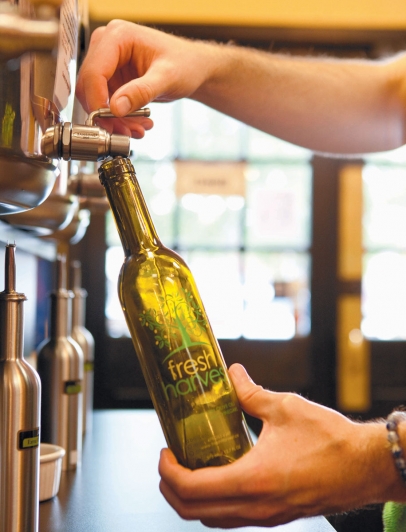Oil and Vinegar
It's a bit surprising that Troy Johnson is a purveyor of olive oils and balsamic vinegars. For years, he'd send back the bowl of olive oil for the bread at a restaurant and request butter instead.
He realized he'd never had high quality olive oil, and his taste buds rejected the commercial olive oil. "I didn't like what I was having, and I couldn't understand why people were so into olive oil," says Johnson, who, with his partner, Steve Ketchersid, opened Fresh Harvest in Eureka Springs in October 2012.
Johnson now knows that independent testing has found that 70 percent of the extra virgin olive oils bought in stores is canola oil, with a little bit of olive oil. Canola oil actually comes from the rapeseed, which is part of the turnip family. "Basically what you're buying is a fraud, a fake," Johnson says.
He easily recalls his first pleasurable olive oil experience, which came at an oil and vinegar shop he stumbled upon in Berkeley, California. The owner had opened the shop with olive oils supplied from her family in Italy. As he tasted fresh olive oil for the first time, he realized, "Wow, this is really different. This is actually good." He was hooked, and he started learning everything he could about both olive oil and balsamic vinegar. Eventually, he decided to recreate that experience in Eureka Springs, and that shop owner became his primary product supplier.
A tour of the store's tasting room is perhaps the best way to understand the Fresh Harvest products and where they come from. Olives are pitted fruits, and balsamic vinegar is made from grapes. "I tell people we are purveyors of fruit juice," he says.
When tasting the olive oils, Johnson describes them in much the same manner as one might expect at a wine tasting. The Oro Bailen Arbequina from Spain is a mild intensity with a 155 level of polyphenols (in parts per million). The flavor – light with hints of apple, grass, herbs, and a bit of pepper – is noticeable when sipping it. The Cobrancosa from Portugal, with 237 polyphenols, is a medium intensity with a creamy flavor with berry endnotes. The Oro Bailen Picual from Spain, with 380 polyphenols, is a robust intensity with what Johnson described as herbaceous notes of "green apple, green tomato, green leaf, green grass – green, green, green."
The company name, Fresh Harvest, was coined because the olives are harvested by hand and then crushed within six hours – timing that is important to preserve the polyphenols. Polyphenols are plant chemicals that serve as antioxidants to protect the cells in the body from free radical damage. "From the moment that olive is picked, it's going to start its cycle of degrading," he says. Typical commercial olive oils contain polyphenols at about 5 or 10 parts per million; Fresh Harvest olive oils range between 150 to 650 parts per million. They post the crush date for their olive oils in the store. A true extra virgin olive oil is most healthy, and at its highest level of polyphenols, at 14 months from the crush date.
Once the oil is out of the fruit, the degradation process slows significantly. The industry standard for levels of free fatty acids is 1 percent; Fresh Harvest's average is about .25 percent. Olive oil with high levels of free fatty acids will burn, but their olive oil can be used for cooking up to about 420 degrees.
Fresh Harvest and some other olive oil providers came together to develop their own certification called Ultra Premium, or UP. It's more stringent than the International Olive Council and the USDA organic designation. "USDA organic is concerned with pesticides and soil rotations, but it doesn't speak to when to harvest, when to crush – it doesn't speak to a lot of things," Johnson says.
All of their olive oils are UP grade. They work with independent farms in both hemispheres, importing from California and countries such as Italy, Spain, Greece, Australia, Chile, and Peru. Currently, about 95 percent of the olive oil in this country is imported. Olives grow in regions that are somewhat dry and hot, but they can tolerate some snow. Georgia and Texas are joining California in olive growing, and Johnson predicts that in the next 15 years or so, once those plants are mature, this country won't need to import much olive oil.
With hundreds of varieties of olives, olive oil can vary in color, texture and flavor based on factors such as the region, the climate, the growing conditions that year, the type of olive it is, and the age of the trees.
The best grade of any olive oil is extra virgin, the first, cold press of the fruit. Because olives are grown in warm climates, they are taken indoors to cool. Anything below 80 degrees is considered a cold press; Fresh Harvest products are done at 75 degrees. The most nutritious oil is found in the outer parts of the fruit, Johnson says. That first press produces extra virgin olive oil; subsequent presses of the olives product other grades, such as pure olive oil.
"We believe strongly that olives are an amazing food to consume. They're one of the top 10 power foods, like walnuts and pomegranates," he says.
Their store also features fused and infused olive oils, offering a wide variety of flavors. For the fused olive oils, the farm that grows the olives also grows the blood oranges, Eureka lemons, mandarin oranges, grapefruits, or peppers. They are harvested and crushed together – just two ingredients – using a centrifuge. For the infused olive oils, fresh herbs in a teabag are submerged into a big fusti pot of olive oil. A vacuum pump draws out the essential oils of the herbs and spices to create an infusion.
In addition to olive oils, they also carry roasted sesame, almond and walnut oils, as well as black and white truffle oils. Their line of dark and white balsamic vinegars include the 18 Year Old Traditional Balsamic Condimento, which is from Modena, Italy, and aged for up to 18 years in chestnut, oak, mulberry, and ash wood barrels.
Johnson uses the fused Blood Orange Olive Oil from Tunisia instead of butter when cooking his holiday turkey. It's also a nice addition to chocolate brownies or cake. And, adding balsamic vinegar to sauces, soups, or stews, can "balance it out really nicely." Johnson's mother's favorite salad dressing is a half-and-half mixture of Persian Lime Olive Oil with Blackberry Ginger Balsamic Condimento, but that blend also can be brushed on salmon on the grill or used to baste or marinate beef tenderloin.
"In a very easy way, you add a lot of flavor to things you normally cook," he says.
BALSAMIC BARBECUE PULLED PORK SLIDERS
Recipe by Troy Johnson
This recipe uses a slow cooker to cook the pork shoulder, but you can also smoke it.
Slow cooking is key for the meat to be pullable and tender.
Ingredients
- 2 pounds 8 ounces boneless pork shoulder roast
- 1 cup chopped onion
- 3/4 cup chopped green pepper
- 1 cup dark beer
- 1/4 cup hickory or mesquite Liquid Smoke
- 1/2 teaspoon dried rosemary
- 1 tablespoon smoked paprika
- 1/2 to 1 cup Balsamic Barbecue Sauce (recipe below)
- 20 cocktail-size hamburger buns ("slider rolls") Coleslaw or pickles (optional)
Instruction
- Trim any excess fat from pork roast.
- Put onion and pepper into bottom of the slow cooker and place pork shoulder on top of them.
- Combine beer and Liquid Smoke and pour over meat. Top with rosemary and smoked paprika.
- Cook on low setting for 9-10 hours, until very tender and cooked through.
- Transfer meat to cutting board and pull pork into shreds using a fork.
- Discard remaining fat, juices, and cooked onion and pepper from cutting board and slow cooker.
- Return the shredded pork to the now empty slow cooker, cover with the barbecue sauce, stir, and cook on low for one hour.
- To serve, spoon meat mixture on to opened buns. Top with coleslaw or pickles (optional).
BALSAMIC BARBECUE SAUCE
Recipe by Troy Johnson
Dual purposes: Try this barbecue sauce with the grilled shiitakes
Ingredients
- 1 cup balsamic vinegar
- 1/2 cup ketchup
- 1/4 cup brown sugar
- 2 cloves garlic, finely minced
- 1 1/2 teaspoons Dijon mustard
- 1 teaspoon freshly ground black pepper
- 1/2 teaspoon granulated onion
- 1/2 teaspoon chipotle powder
- 1/2 teaspoon smoked paprika
Instructions
- Combine all ingredients in a small saucepan, stir well, and simmer for 30 minutes over low heat.
- Stir occasionally until reduced by nearly one half, or to the consistency you prefer, then remove from heat. It will thicken even more after standing.
Additional recipes are available on their website.






